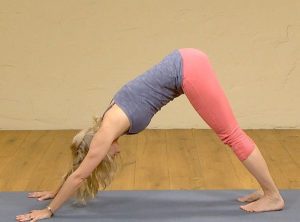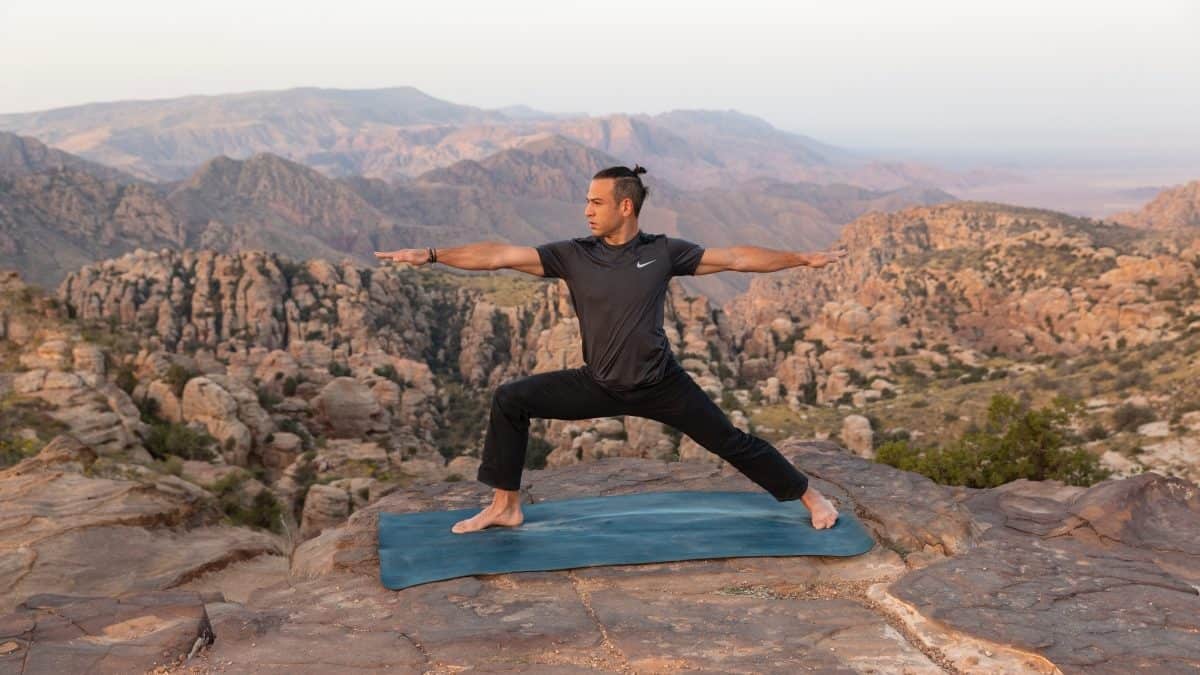
Yoga for hypothyroidism is beneficial for many reasons. It is a journey into the self that helps reverse the effects of hypothyroidism. Many people suffer from thyroid disorders. They can have a significant impact on metabolism, growth and body temperature. Yoga can help you prevent or control symptoms of a thyroid disorder.
Yoga poses can help promote thyroid health. The basic fish posture and the downward facing dogs will stimulate your thyroid gland. This will promote overall good health. Cobra pose is a restorative, non-stressful inversion that does NOT put pressure on the neck. To support your neck, you can use a cushion or blanket. Start by placing your right leg against the wall. Next, bend your knees and allow your hands to touch your neck. When you feel comfortable, inhale deeply while keeping your eyes open.

The wheel pose is the next position. This is the most well-known pose in yoga to treat hypothyroidism. The purpose of this pose is to improve the flow of blood to the thyroid gland. By bending your knees while keeping your elbows flexed, you can achieve this pose. This poses strengthens abdominal muscles and calms nervous system. A good pose to practice while undergoing treatment for hypothyroidism is a seated bow pose.
Asanas for hypothyroidism include the upward bow pose, or Urdhva Dhanurasana. This pose aids in providing energy to the thyroid and can be beneficial for those with back pain. If you have back pain, this pose is not for you. When performing the pose, you should bend your elbows.
People with hypothyroidism can try shoulderstand yoga. This inversion is believed to increase blood circulation to the thyroid and to improve its efficiency. Tucking your chin into your chest can improve the function and health of the thyroid. To do shoulderstand, you need to lie flat on one side. When you press into the floor, keep your hands at your sides.

Camel pose is a powerful, powerful position that improves blood circulation around the thyroid and increases circulation in the neck. It can be held for up to one minute, depending on the practitioner. To perform the pose, you need to be able to hold it with your knees in line, breathe deeply, and keep your chin tucked. Ideally, you should be able to hold this pose for three minutes.
FAQ
What is a good seven-day workout routine?
Three days per week should be spent on cardiovascular training, including running, biking, swimming, and two strength exercises using free weights, weight machine, as well as one flexibility/core exercise such as yoga, Pilates. It's essential to do each activity at least once a week. Each session should not last more than 45 minutes.
Cardiovascular Exercises: Swimming, Cycling, Running
Aim to do at least 60 minutes per week of cardio. For best results, aim for 75 minutes per week. Cardio exercise can stimulate blood flow and increase muscle growth.
Strength Training
While cardio exercises target the heart and lungs, strength training targets the muscles and bones. Strength training can help you burn calories even when you're not working out.
Flexibility & Core Workouts
You can strengthen your entire body by strengthening flexibility and core exercises. Both yoga or Pilates are great options.
Eggs are good for us.
The egg is rich in all nutrients needed by the human body. It supports strong bones, healthy heart, lungs, and stable blood sugar.
Eggs are an excellent source protein, vitamins A,B12, D E, K and calcium. They also contain vitamin B12, D-E, K, calcium and phosphorus.
Egg yolks are high in cholesterol. It does not contain any saturated fat. Eggs contain less saturated fat than most other foods.
They are also low on calories and sodium. They are also very versatile because you can cook them any way you want. They can be fried, poached, scrambled, boiled, hard-boil and baked.
They are very nutritious and easy-to-prepare.
At least two whole eggs should be consumed each day. You should eat eggs if you are allergic to them.
Essential nutrients are provided by eggs. Consider adding eggs to your daily meal plan today.
Do I have the obligation to exercise every day or just on occasion?
No! No! That means walking fast enough to be slightly out of breath or biking hard enough to sweat.
Why Metabolic Well-being is the Key to Aging Well
People live longer today than ever before. However, as they age, so do their chances of getting sicker. And while we've made great strides in medical science, it's becoming increasingly clear that our current approach isn't working.
We need to change how we think about health and aging. Healthful aging requires that we start to think about metabolic health, which is not only weight loss but overall well-being.
And if you want to live an active life for decades to come, you should ensure that your metabolism stays strong and healthy throughout your entire lifetime.
The good news is that there are many ways to improve your metabolic health. One way is to include these 7 foods in your diet.
-
Resveratrol has been proven to increase cellular longevity. They also contain vitamins C & E, as well as antioxidants.
-
Beans such as pinto beans and lentils provide excellent fiber and plant protein. These nutrients help maintain blood sugar levels so they don’t spike and fall.
-
Broccoli contains sulforaphane, shown in studies to protect cells against DNA damage. It could even slow down the growth of cancer.
-
Chia Seeds are high in omega-3 fatty acids and fiber. They are also high in antioxidants and proteins. These nutrients promote gut health, brain function and heart health.
-
Green Tea contains polyphenols called caechins. Studies have shown that green tea contains catechins which are linked to lower bone fractures and cardiovascular disease. They also reduce cognitive decline and diabetes risk.
-
Salmonis a great source of lean protein. It is low in saturated fat and high in vitamin D.
-
Walnuts have omega-3s and antioxidants such as alphalipoic acid (ALA). ALA boosts energy production and reduces inflammation.
Is Cardio Exercise Good Or Bad For Your Health?
Cardiovascular exercise can have many benefits. It improves blood circulation, strengthens heart muscle, gives you energy, and can even help you lose weight.
Cardiovascular exercise includes running, biking, hiking, swimming, tennis, basketball, soccer, volleyball, football, etc.
Cardio exercises should be avoided at high intensity levels. Doing this could lead to injury.
The cardiovascular exercise should only be performed if you feel good.
Do not push yourself to the limit. In this way, you may injure or even kill yourself.
It is important to warm up before you begin any cardiovascular exercise. Start slowly increasing your intensity.
You must always listen to what your body is telling you. You should stop immediately if you feel any pain while doing cardiovascular exercise.
After a cardiovascular training session, it is recommended that you take some time to relax. This gives your muscles the chance to heal.
Cardiovascular exercise can help you lose weight.
This is the best way to lose weight and belly fat.
Which order is best for working out?
It all depends on what you're looking for. First, lift heavy weights if you are looking to increase muscle mass. Next, you can move onto cardio. Then if you want to lose weight, go from cardio to strength training.
Cardio can be done if you want to just lose fat. You can then add strength training.
Do cardio first if you are looking to increase muscle mass. It stimulates growth hormones that help build muscle mass.
It is important to eat before going to work out. This will fuel your muscles, making them work harder. This will make you feel better while working out.
Statistics
- Candidates and applicants must pass all four tests at 70% (minimum level) to graduate from Basic Deputy U.S. Marshal (BDUSM) Training. (usmarshals.gov)
- Get free shipping and 25% off today. (healthline.com)
- 10 pounds in a month is likely during a lean bulking phase, especially for beginners. (muscleandstrength.com)
- By John Thompson Take a whopping 38% off a set of PowerBlock Pros. (menshealth.com)
- Cardmembers earn 5% Back at Amazon.com with a Prime Credit Card. (amazon.com)
External Links
How To
What is the best food for men to eat?
Men should consume five portions of fruits and veggies per day. They should limit their intake of red meat, and avoid fast food.
Antioxidants are found in fruits and vegetables, which protect against cardiovascular disease and other diseases.
Vegetables include broccoli, cauliflower, carrots, spinach, tomatoes, peppers, cucumbers, lettuce, mushrooms, etc.
Peas and beans are also high in protein and fiber.
A great source of omega-3 fatty acid is nuts and seeds. Essential for hormone production and brain function, omega-3 fatty acids are vital.
Another good source of omega-3s is fish. More mercury is found in fish than any other meats. However, fish liver oil does contain fewer toxins.
For normal growth and development, Omega-6s are required in vegetable oils such as soybean, sunflower, safflower and cottonseed oils.
Poultry is a good source for lean protein. Chicken breast is one of the healthiest meats.
Lean beef is low-in saturated fats as well as cholesterol. Avoid eating too many red meats as iron intake can increase the risk of developing prostate cancer.
Avoid processed meats like sausage and hot dogs. These meats can be carcinogenic because they contain nitrates.
No doubt exercise is crucial for good health. But what if you're already working out regularly? Is there anything else you can do to maintain or improve your physical condition?
The answer is yes! There are many things you can do to get the best out of your workouts. These are some tips that will help you get the most out of your workouts.
Take it slow. Injure yourself if your first session is too intense. You should start at a pace that you are comfortable with and increase your intensity gradually.
Stretch before and afterwards. Stretching will loosen tight muscles and increase flexibility. You can stretch by lying down, standing up, or walking around.
Cool down. This is especially important if you're doing cardio exercises. So that your body doesn't become exhausted, it needs to be able to recover between sessions. You can cool off by taking slow, deep breaths and walking.
Hydrate. Hydration is key to reducing muscle cramps and keeping you hydrated. Water is the ideal drink, but sports drinks can also help.
Eat right. Make sure you are getting enough calories each day. Regular meals throughout the day can help you stay focused and energized during your workouts.
Get enough rest. You'll wake up feeling refreshed and ready to start your next workout when you sleep properly. It is essential to get enough sleep in order to repair damaged tissues.